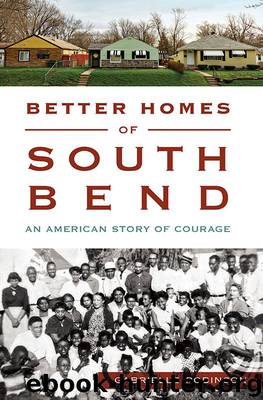Better Homes of South Bend: An American Story of Courage (American Heritage) by Robinson Gabrielle

Author:Robinson, Gabrielle [Robinson, Gabrielle]
Language: eng
Format: epub
Publisher: Arcadia Publishing Inc.
Published: 2015-09-07T04:00:00+00:00
Schuler Braboy, Joseph Roberson, Eugene Northern, Robert Graham, Donald Howell and Herschel Collier all dropped out. After two new families joined, in the end there were twenty-two lots spoken for on North Elmer Street. Louis Stanford and Frank Anderson were the newcomers, and they were given the last Better Homes lots in the 1800 block of North Elmer, Stanford at 1834 and Anderson at 1830. By the time Anderson joined, he had to pay $600 for his lot.
Several names on that list of house assignments have not yet been identified because neither husband nor wife served as an officer in Better Homes. But they, too, followed the pattern of northward migration, most of them arriving in South Bend in the 1940s. Three came from Tennessee. Eugene Northern and his wife, Ellen, were born in Jackson, where they got married in 1930. They came to South Bend shortly thereafter. Willie Gillespie was from Memphis and came to South Bend as a young man in 1948. Millie Fleming was from Elkton, Tennessee. Two were from Kentucky. Albert Warfield was born in Earlington in 1909 and arrived in South Bend in 1940. John Fleming came from Hopkinsville. He and his wife moved to South Bend in the 1940s. Two members were from Arkansas. Rosie was born in 1918 in Wabbaseka and married Albert Warfield in South Bend in 1948. Bozzie Williams came to South Bend from Marked Tree, Arkansas. There were two also from Louisiana—Clint Taylor from Baton Rouge and Robert Allen from New Orleans—who both arrived in South Bend in the 1940s.
The rest were from a different state each: Lila Williams from Dover, North Carolina; Louis Stanford from West Virginia; Walter Hubbard from Leland, Mississippi; and Orbry Chambers from Cairo, Illinois. That leaves only James Adams unaccounted for, but Leroy Cobb is certain that he, too, was originally from the South. Out of the whole group, only F.D. Coker, Orbry Chambers and Louis Stanford did not work for Studebaker.
The assignment of lots and house numbers had the desired effect of cheering them on with the promise of success. And then came another piece of good news. On October 19, Allen could tell the board of directors that the FHA had formally agreed to handle the permanent mortgages. Members had to come up with a 10 percent down payment up to a total of $5,000 and ⅓ percent down on each $1,000 in excess of the first $5,000.
The valuation of the improvements was not yet definite, however. For each family, the total cost of improvements should not exceed half the cost of the lots. Allen submitted letters of petition for sewage and water. Yet deadlines and promised dates of completion passed without noticeable progress, and again there was discontent among the members. So the “deeds were passed for inspection and to dispel any rumors that definite progress was not being made by the corporation.”
Allen stressed once more that cooperative building was the best means for building and explained this further at the general meeting of October 26.
Download
This site does not store any files on its server. We only index and link to content provided by other sites. Please contact the content providers to delete copyright contents if any and email us, we'll remove relevant links or contents immediately.
| Anthropology | Archaeology |
| Philosophy | Politics & Government |
| Social Sciences | Sociology |
| Women's Studies |
Cecilia; Or, Memoirs of an Heiress — Volume 1 by Fanny Burney(32064)
Cecilia; Or, Memoirs of an Heiress — Volume 3 by Fanny Burney(31459)
Cecilia; Or, Memoirs of an Heiress — Volume 2 by Fanny Burney(31409)
The Great Music City by Andrea Baker(30784)
We're Going to Need More Wine by Gabrielle Union(18636)
All the Missing Girls by Megan Miranda(14749)
Pimp by Iceberg Slim(13781)
Bombshells: Glamour Girls of a Lifetime by Sullivan Steve(13689)
Fifty Shades Freed by E L James(12918)
Talking to Strangers by Malcolm Gladwell(12881)
Norse Mythology by Gaiman Neil(12836)
For the Love of Europe by Rick Steves(11533)
Crazy Rich Asians by Kevin Kwan(8891)
Mindhunter: Inside the FBI's Elite Serial Crime Unit by John E. Douglas & Mark Olshaker(8707)
The Lost Art of Listening by Michael P. Nichols(7165)
Enlightenment Now: The Case for Reason, Science, Humanism, and Progress by Steven Pinker(6877)
The Four Agreements by Don Miguel Ruiz(6322)
Bad Blood by John Carreyrou(6281)
Weapons of Math Destruction by Cathy O'Neil(5837)
